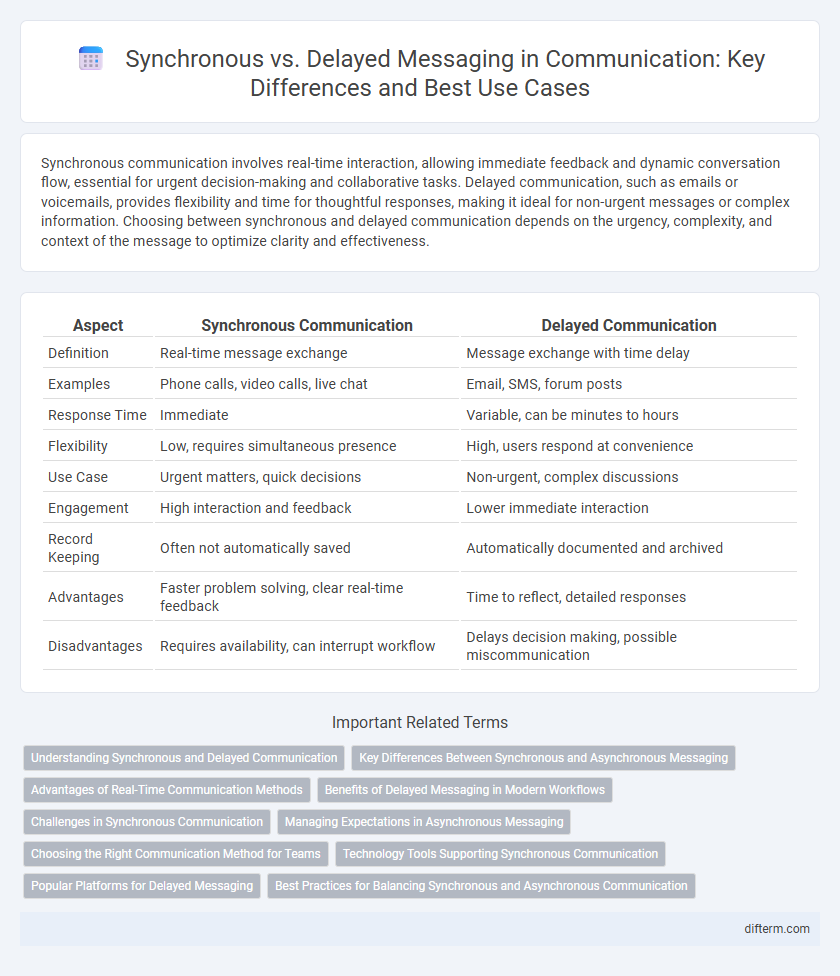Synchronous communication involves real-time interaction, allowing immediate feedback and dynamic conversation flow, essential for urgent decision-making and collaborative tasks. Delayed communication, such as emails or voicemails, provides flexibility and time for thoughtful responses, making it ideal for non-urgent messages or complex information. Choosing between synchronous and delayed communication depends on the urgency, complexity, and context of the message to optimize clarity and effectiveness.
Table of Comparison
| Aspect | Synchronous Communication | Delayed Communication |
|---|---|---|
| Definition | Real-time message exchange | Message exchange with time delay |
| Examples | Phone calls, video calls, live chat | Email, SMS, forum posts |
| Response Time | Immediate | Variable, can be minutes to hours |
| Flexibility | Low, requires simultaneous presence | High, users respond at convenience |
| Use Case | Urgent matters, quick decisions | Non-urgent, complex discussions |
| Engagement | High interaction and feedback | Lower immediate interaction |
| Record Keeping | Often not automatically saved | Automatically documented and archived |
| Advantages | Faster problem solving, clear real-time feedback | Time to reflect, detailed responses |
| Disadvantages | Requires availability, can interrupt workflow | Delays decision making, possible miscommunication |
Understanding Synchronous and Delayed Communication
Synchronous communication involves real-time interaction where participants exchange messages instantly, fostering immediate feedback and dynamic dialogue. Delayed communication, on the other hand, allows for time lag between message sending and receiving, providing flexibility but potentially slowing decision-making processes. Understanding these modes helps organizations balance responsiveness and reflection in their communication strategies.
Key Differences Between Synchronous and Asynchronous Messaging
Synchronous messaging requires participants to engage in real-time communication, enabling instant responses and immediate clarification, which is vital for dynamic conversations or urgent decision-making. Asynchronous messaging allows users to send and receive messages without requiring simultaneous presence, offering flexibility and time for thoughtful responses, making it ideal for remote teams and global collaboration. Key differences include response time, communication flow, and context retention, where synchronous methods provide faster interaction but demand simultaneous availability, while asynchronous tools support time-shifted communication and often include message history for reference.
Advantages of Real-Time Communication Methods
Real-time communication methods enhance team collaboration by enabling instant feedback and immediate decision-making, which reduces misunderstandings and accelerates project timelines. These synchronous interactions, such as video calls or live chats, foster stronger interpersonal connections and improve engagement by allowing participants to convey tone and emotion effectively. The prompt exchange of information supports rapid problem-solving and adaptability in dynamic work environments.
Benefits of Delayed Messaging in Modern Workflows
Delayed messaging in modern workflows enhances productivity by allowing employees to respond thoughtfully without the pressure of immediate replies, reducing stress and interruptions. It supports asynchronous collaboration across different time zones, promoting flexibility and better work-life balance. This approach also enables better prioritization of tasks, as messages can be addressed at optimal times, improving overall workflow efficiency.
Challenges in Synchronous Communication
Synchronous communication faces challenges such as time zone differences, which complicate real-time interactions and reduce efficiency. Immediate responses demand constant availability, leading to potential burnout and decreased productivity. Background noise and technical issues can disrupt the flow, impacting message clarity and understanding.
Managing Expectations in Asynchronous Messaging
Managing expectations in asynchronous messaging requires clear guidelines on response times to prevent misunderstandings and frustration. Establishing agreed-upon time frames for replies helps maintain productivity and supports effective communication across different time zones. Transparent communication policies optimize collaboration by balancing flexibility with reliable information flow in remote or distributed teams.
Choosing the Right Communication Method for Teams
Selecting the appropriate communication method for teams depends on the urgency and complexity of information exchanged. Synchronous communication, such as video calls or instant messaging, enables real-time interaction and immediate feedback, ideal for brainstorming or resolving issues quickly. Delayed communication methods like emails or project management tools support thoughtful, asynchronous updates and documentation, enhancing productivity for distributed or flexible schedules.
Technology Tools Supporting Synchronous Communication
Technology tools supporting synchronous communication include platforms like Zoom, Microsoft Teams, and Slack, which enable real-time video conferencing, instant messaging, and collaborative workspaces. These tools facilitate immediate feedback, enhance team collaboration, and reduce misunderstandings by allowing participants to interact simultaneously. Integration with features such as screen sharing, live document editing, and presence indicators further optimizes user engagement and productivity during live communication sessions.
Popular Platforms for Delayed Messaging
Popular platforms for delayed messaging include email services like Gmail and Outlook, which enable users to schedule messages for future delivery. Slack and Microsoft Teams offer options to draft and send messages later, supporting asynchronous communication in team environments. Social media tools such as Facebook Messenger and WhatsApp also allow users to send voice notes or texts that recipients can reply to at their convenience, enhancing flexibility in communication timing.
Best Practices for Balancing Synchronous and Asynchronous Communication
Effective communication requires balancing synchronous methods like video calls and instant messaging with asynchronous tools such as emails and collaboration platforms. Prioritizing synchronous interactions for urgent decision-making and real-time brainstorming enhances clarity, while asynchronous communication supports thoughtful responses, documentation, and flexibility across time zones. Establishing clear guidelines on when to use each approach reduces overload, improves productivity, and fosters collaboration.
synchronous vs delayed (messages) Infographic

 difterm.com
difterm.com